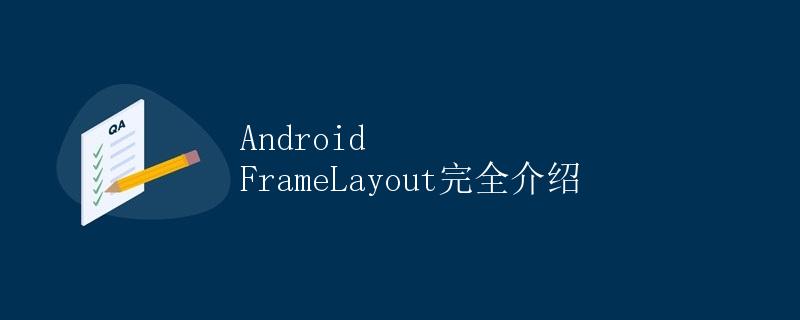Android FrameLayout完全介绍

1. 什么是FrameLayout
FrameLayout是Android中最简单和最常用的布局之一,它可以理解为一个“帧”或“容器”,用于包裹其他视图组件。它可以容纳多个子视图,并且可以通过调整它们的位置和大小来实现特定的布局效果。
FrameLayout的特点如下:
- FrameLayout只允许添加一个子视图,且默认情况下子视图会叠加显示在同一位置;
- 子视图的层叠顺序由添加的顺序决定,后添加的子视图位于顶部;
- 可以使用layout_gravity属性来设置子视图的位置,如左上角、右上角、居中等;
- FrameLayout不支持子视图之间的相对关系和权重。
2. FrameLayout的基本用法
FrameLayout的基本用法非常简单,只需要在布局文件中添加FrameLayout标签,并在其中添加子视图即可。以下是一个示例代码:
<FrameLayout xmlns:android="http://schemas.android.com/apk/res/android"
android:layout_width="match_parent"
android:layout_height="match_parent">
<ImageView
android:layout_width="wrap_content"
android:layout_height="wrap_content"
android:src="@drawable/image" />
</FrameLayout>
上述代码中,我们在FrameLayout中添加了一个ImageView作为子视图。ImageView的宽高设置为wrap_content,这样它将根据图片的大小自动调整大小。
3. FrameLayout的布局位置
3.1 使用layout_gravity属性
FrameLayout可以通过使用layout_gravity属性来设置子视图的位置。layout_gravity属性可以设置为以下值:
- top:在上方居中显示
- bottom:在下方居中显示
- left:在左侧居中显示
- right:在右侧居中显示
- center_vertical:在垂直方向上居中显示
- center_horizontal:在水平方向上居中显示
- center:在水平和垂直方向上居中显示
以下是一个示例代码:
<FrameLayout xmlns:android="http://schemas.android.com/apk/res/android"
android:layout_width="match_parent"
android:layout_height="match_parent">
<ImageView
android:layout_width="wrap_content"
android:layout_height="wrap_content"
android:src="@drawable/image"
android:layout_gravity="center" />
</FrameLayout>
上述代码中,我们设置了ImageView的layout_gravity属性为center,这样它将在FrameLayout中居中显示。
3.2 使用margin属性
除了使用layout_gravity属性,还可以使用margin属性来设置子视图的位置。以下是一个示例代码:
<FrameLayout xmlns:android="http://schemas.android.com/apk/res/android"
android:layout_width="match_parent"
android:layout_height="match_parent">
<ImageView
android:layout_width="wrap_content"
android:layout_height="wrap_content"
android:src="@drawable/image"
android:layout_marginLeft="20dp"
android:layout_marginTop="10dp" />
</FrameLayout>
上述代码中,我们设置了ImageView的layout_marginLeft属性为20dp,layout_marginTop属性为10dp,这样它将在距离左边缘20dp和上边缘10dp的位置显示。
4. FrameLayout的层叠效果
FrameLayout的特点之一是可以将多个子视图层叠显示,通过调整子视图的位置可以实现不同的布局效果。以下是一个示例代码:
<FrameLayout xmlns:android="http://schemas.android.com/apk/res/android"
android:layout_width="match_parent"
android:layout_height="match_parent">
<ImageView
android:layout_width="wrap_content"
android:layout_height="wrap_content"
android:src="@drawable/image" />
<TextView
android:layout_width="wrap_content"
android:layout_height="wrap_content"
android:text="Hello World"
android:textSize="20sp"
android:textColor="#000000" />
</FrameLayout>
上述代码中,我们在FrameLayout中添加了一个ImageView和一个TextView。由于TextView在ImageView之后添加,所以TextView会显示在ImageView的上方。
5. FrameLayout的注意事项
在使用FrameLayout时,有几个注意事项需要注意:
5.1 子视图叠加
默认情况下,FrameLayout中的子视图会叠加显示在同一位置。如果需要显示多个子视图,需要通过调整它们的位置来避免重叠。
5.2 子视图顺序
FrameLayout中子视图的层叠顺序由添加的顺序决定,后添加的子视图位于顶部。如果需要调整子视图的层叠顺序,可以通过改变它们的添加顺序来实现。
5.3 父视图大小
FrameLayout的宽高可以设置为match_parent或固定值,但需要注意确保子视图不会超出父视图的范围,否则可能导致部分内容被裁剪或显示不完整。
6. FrameLayout的案例分析
6.1 案例描述
我们要实现一个简单的图片浏览器应用,该应用界面包含一个ImageView用于显示图片,并在图片上方添加一个半透明的文字区域,用于显示图片描述。以下是代码示例:
<FrameLayout xmlns:android="http://schemas.android.com/apk/res/android"
android:layout_width="match_parent"
android:layout_height="match_parent">
<ImageView
android:layout_width="match_parent"
android:layout_height="match_parent"
android:src="@drawable/image" />
<LinearLayout
android:layout_width="match_parent"
android:layout_height="wrap_content"
android:orientation="vertical"
android:background="@color/transparent"
android:layout_gravity="bottom">
<TextView
android:layout_width="match_parent"
android:layout_height="wrap_content"
android:text="Image Description"
android:textColor="#FFFFFF"
android:textSize="16sp"
android:padding="10dp" />
</LinearLayout>
</FrameLayout>
上述代码中,我们使用FrameLayout作为根布局,添加了一个ImageView用于显示图片,并在其上方添加了一个LinearLayout作为文字区域,实现了半透明的文字覆盖效果。
总结
本文介绍了Android中FrameLayout的基本用法、布局位置、层叠效果和注意事项,并通过一个案例分析展示了FrameLayout的实际应用场景。FrameLayout是Android布局中简单而常用的一种,可以用于实现多种布局效果,但需要注意子视图的叠加和顺序关系,以及父视图的大小限制。## 7. FrameLayout的常见问题和解决方案
7.1 子视图覆盖问题
当我们在FrameLayout中添加多个子视图时,可能会出现覆盖问题,即后添加的子视图覆盖在前一个子视图之上。解决这个问题的方法有两种:
- 调整子视图的添加顺序,将需要显示在上方的子视图后添加;
- 使用layout_gravity属性或margin属性来调整子视图的位置,使它们在不重叠的位置显示。
7.2 子视图超出范围问题
当子视图的大小超过了FrameLayout的范围时,可能会导致部分内容被裁剪或显示不完整。解决这个问题的方法有两种:
- 调整子视图的大小,使其不超过FrameLayout的范围;
- 使用ScrollView等可滚动的父视图来包裹FrameLayout,以便用户可以滑动查看完整内容。
7.3 子视图位置调整问题
如果需要精确调整子视图的位置,使用layout_gravity属性可能无法满足需求,可以通过添加额外的布局容器来实现。以下是一个示例代码:
<FrameLayout xmlns:android="http://schemas.android.com/apk/res/android"
android:layout_width="match_parent"
android:layout_height="match_parent">
<LinearLayout
android:layout_width="match_parent"
android:layout_height="match_parent"
android:orientation="vertical">
<ImageView
android:layout_width="match_parent"
android:layout_height="wrap_content"
android:src="@drawable/image" />
<LinearLayout
android:layout_width="match_parent"
android:layout_height="wrap_content"
android:orientation="horizontal">
<TextView
android:layout_width="wrap_content"
android:layout_height="wrap_content"
android:text="Left"
android:textSize="16sp"
android:padding="10dp" />
<View
android:layout_width="0dp"
android:layout_height="0dp"
android:layout_weight="1" />
<TextView
android:layout_width="wrap_content"
android:layout_height="wrap_content"
android:text="Right"
android:textSize="16sp"
android:padding="10dp" />
</LinearLayout>
</LinearLayout>
</FrameLayout>
上述代码中,我们使用了两个LinearLayout,一个作为父容器包裹ImageView和另一个LinearLayout;另一个LinearLayout作为子容器用于调整文本视图的位置。通过添加额外的布局容器,我们可以更灵活地调整子视图的位置。
8. 总结
本文详细介绍了Android中FrameLayout的基本用法、布局位置、层叠效果和注意事项,并通过案例分析展示了FrameLayout的实际应用场景。同时,我们也讨论了FrameLayout中可能遇到的常见问题,并提供了相应的解决方案。
 极客笔记
极客笔记